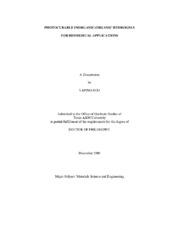| dc.description.abstract | There are two primary objectives of this dissertation research. The first objective
was to prepare a library of inorganic-organic hydrogels from methacrylated star
polydimethylsiloxane (PDMSstar-MA) and diacrylated poly(ethylene oxide) (PEO-DA)
with tunable chemical and physical properties for use as tissue engineering scaffolds.
These inorganic-organic hydrogels provide a useful platform to study the effect of
scaffold properties on cell behavior in tissue culture.
Twenty compositionally unique hydrogels were prepared by photo-crosslinking
varing molecular weights (Mn) of PEO-DA (Mn = 3.4k and 6k g/mol) and PDMSstar-MA
(Mn = 1.8k, 5k and 7k g/mol) at varying weight ratios (up to 20 wt% PDMSstar-MA).
Introduction of PDMSstar-MA caused formation of discrete PDMS-enriched "microparticles"
dispersed within the PEO hydrogel matrix. The swelling ratio, mechanical
properties in tension and compression, non-specific protein adhesion and cytotoxicity of
hydrogels were studied.
The second objective was to prepare thermoresponsive nanocomposite hydrogels,
which are mechanically robust and can remove adhered cells via thermal modulation. Such hydrogels may be useful as "self-cleaning" membranes for implanted biosensors to
extend their lifetime and efficiency. These hydrogels are comprised of a poly(Nisopropylacrylamide)
(PNIPAAm) hydrogel matrix and polysiloxane colloidal
nanoparticles (~220 nm and 50 nm ave. diameter). Due to the low preparation
temperature, the nanocomposite hydrogels exhibited a homogeneous morphology by
SEM analysis. The volume phase transition temperature (VPTT, ~33 degrees C) of the
nanocomposite hydrogels was not altered versus the pure PNIPAAm hydrogel, which is
near body temperature. Generally, nanoparticles led to improve mechanical properties
versus pure PNIPAAm hydrogels. When these nanocomposite hydrogels are heated
above the VPTT, they become more hydrophobic. When they are reversibly switched
from a water-swollen to a deswollen state, the change in surface properties, as well as
swelling-deswelling, was effective upon the removal of adhered cells. | en |


